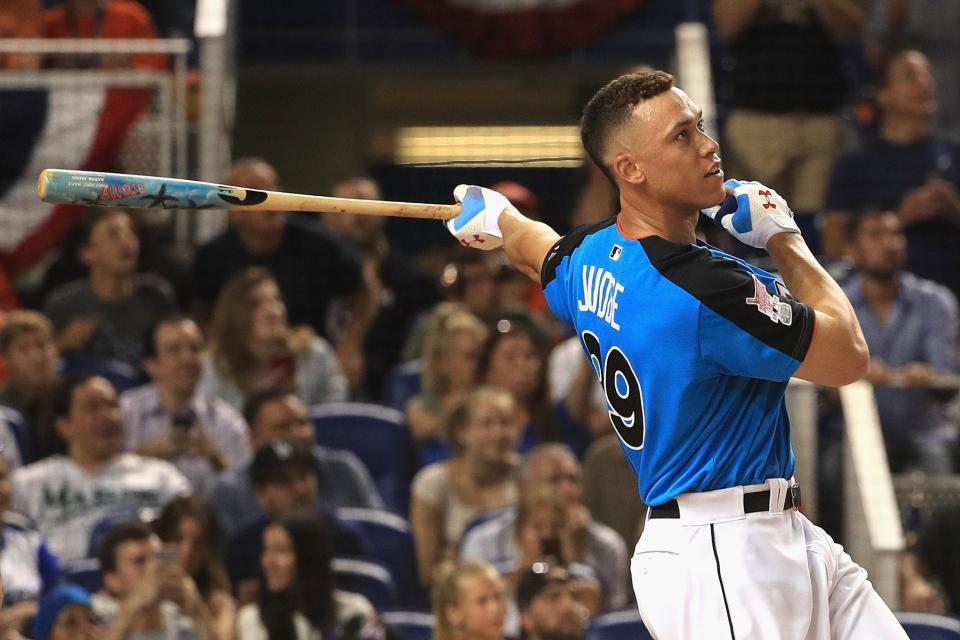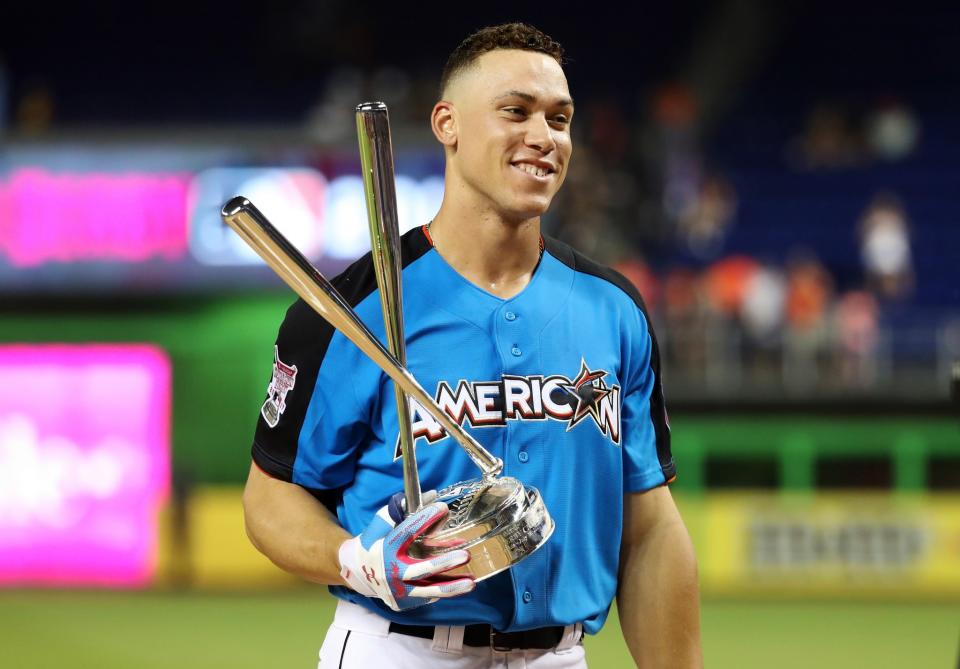Aaron Judge's legendary Home Run Derby performance introduced the world to baseball's newest star
MIAMI – One hundred fifty years ago, when baseball was in its infancy, never could it have dreamed of a night like Monday, of a man like Aaron Judge. He does things to a baseball that defy comprehension and test the limits of physics and remind the jaded masses of the human body’s ability to perform wondrous feats. Progress is typically a slow burn. Judge took an evolutionary leap over a conflagrant two hours.
The evening ended at 10:20 p.m. ET on the 80th swing of Judge’s Home Run Derby-winning, star-affirming, zeitgeist-capturing show. Forty-seven went for home runs, the kill shot a 458-foot screamer to center field. They traveled 3.9 miles total, the shortest 372 feet, the longest 513. Three more exceeded the 500-foot mark. Balls went to left, center, right, ricocheted off the glass wall to his pull side and the hands of those bold enough to believe they can catch something that steamed off the bat at 110 mph-plus and the acid-trip sculpture in center field at Marlins Park, the stadium that served as Judge’s playground.
He is 25 years old and a rookie and a New York Yankee, and those three things together make him the star baseball needs. Mike Trout is one of the best players ever and Bryce Harper a wonderful representative of what baseball can be, but Aaron Judge is something altogether different, a 6-foot-7, 282-pound, right-handed singularity – a specimen whose ability can make a sport rethink its limits because he stretches so beyond what was believed to be possible.
“I’ve never seen somebody hit a ball like that in my life,” Kansas City Royals catcher Salvador Perez said. “Never ever ever ever ever ever.”
He took a moment to consider Judge’s performance before saying something that might be blasphemous were it not absolutely true.
“Not Babe Ruth,” Perez said. “I don’t think anybody could hit the ball like that.”

If this all sounds like hyperbole, it’s only because Judge traffics in the hyperbolic. He entered the Derby as the favorite following a first half in which he thumped 30 home runs and slashed .329/.448/.691. He saw his opponent in the first round, the Marlins’ Justin Bour, whack 22 home runs, and though the sellout crowd ostensibly had shelled out hundreds of dollars a ticket in hopes of Judge facing another Marlin, Giancarlo Stanton, he was showered with boos. After his seventh home run landed 501 feet away, Judge turned the fans for good. He was about to put on a show to rival – and, eventually, exceed – Josh Hamilton and Mark McGwire and the rest of the legendary Derby participants.
“Once Justin put on a show like that,” Judge said, “I just had to go to work.”
Work. That’s a funny word. Because when Aaron Judge swings a bat, it looks like anything but. It’s what makes scouts marvel the most. His swing is so … easy. The knock on players of Judge’s size – the reason so few have sustained major league careers – is because honing and repeating a swing with such long levers takes an immense amount of effort. Just last fall, when Judge joined the Yankees, he looked positively lost. He batted .179 and struck out 42 times in 84 at-bats. The too-big-to-succeed stereotype dogged him. Coming into spring training, he wasn’t guaranteed the right-field job.
Today, to dream of the Yankees without him – to dream of baseball without him – is depressing. The star-making machines of the NFL and NBA don’t translate in baseball. It is a parochial game. The relevance of the All-Star week waned in recent years because of it, and even though a new timed format imbued the Derby with an energy it long lacked, the paucity of instantly recognizable names left it, as so much else in the sport, something for the die-hards.
Though three months does not make a star, Judge’s power, his pinstripes, his age, his marketability and his unfailing likeability do make him the finest crossover candidate to play baseball since Ken Griffey Jr. twisted his cap backward and inspired a generation now in its 30s and 40s. Baseball constantly crowns the next big thing. After too many Joffrey Baratheons, Judge may be Daenerys Stormborn, his dragon a bat.
“He’s an animal,” said Twins third baseman Miguel Sano, whom Judge dispatched in the finals. “That’s all I can say about him. The first time I saw Aaron Judge hitting BP, I can tell you: He’s a monster.”
Ousting Bour was one thing. Following up with shots of 504 feet and 513 feet and 507 feet to expel fellow rookie Cody Bellinger in the second round was another. Eleven home runs in the finals to beat Sano felt like a forgone conclusion, and Judge’s last came with nearly two minutes left on the clock, time the crowd would’ve happily spent watching him do what he does so well.
“I really think this whole thing was a big trick,” Tampa Bay outfielder Corey Dickerson said. “I think they should’ve just let him hit and let everyone enjoy it.”
Dickerson swooned not at Judge’s 500-foot-plus moonshots or the towering drive stopped only by the roof but how easy he made 400-foot home runs to the opposite field look. Those are the ones that make him a ballplayer’s ballplayer, that are the envy of everyone who endeavors to pick up a bat and has the gumption to hit 100-mph pitches with it. Anyone can pull a home run a long way. Nobody can go oppo with the effortlessness of Judge.
That, more than anything, makes him an aberration. The prospect of him facing Stanton in the finals was delicious because he is Stanton evolved. The Marlins lavished Stanton with a $325 million deal in hopes he would become what Judge already is, a fully formed hitter whose power recalibrates previously held notions of what power truly can be.
It would be one thing were Judge to show this in batting practice only. The fact he was the game’s best hitter in the first half almost emboldens what he did in the Derby, lending it the gravitas that shows he’s more than a guy who can hit 70-mph pitches to another area code. All Judge asked Danilo Valiente, the Yankees’ batting-practice pitcher, was to keep the ball somewhere he could hit it, and Valiente obliged, knowing that Judge possesses the game’s largest nitro zone.

“It was absolutely incredible,” Valiente said. “He set out to do it, and he did it, and it was amazing to be able to watch it.”
He was speaking for himself, but Valiente may as well have been the spokesman for those lucky enough to have tuned in. This was just an exhibition, and a gimmicky one at that, and yet it felt bigger, like those who have spoken about Judge in such sycophantic terms since April were validated. Baseball, the longest slog in sports, doesn’t have many events. This was a capital-E Event.
And one can only hope it isn’t the last, that Judge isn’t like Michael Jordan, who grew too big for the Slam Dunk contest and eventually ceded to the less worthy. The Home Run Derby was made for Aaron Judge and vice versa. It’s the sort of thing that reignites excitement, that takes a sport from afterthought to front burner. It warps minds and pushes boundaries and incites giddiness. And on Monday night, it was baseball at its finest, with its newest star burning bright in the Miami sky.
More MLB coverage on Yahoo Sports:


